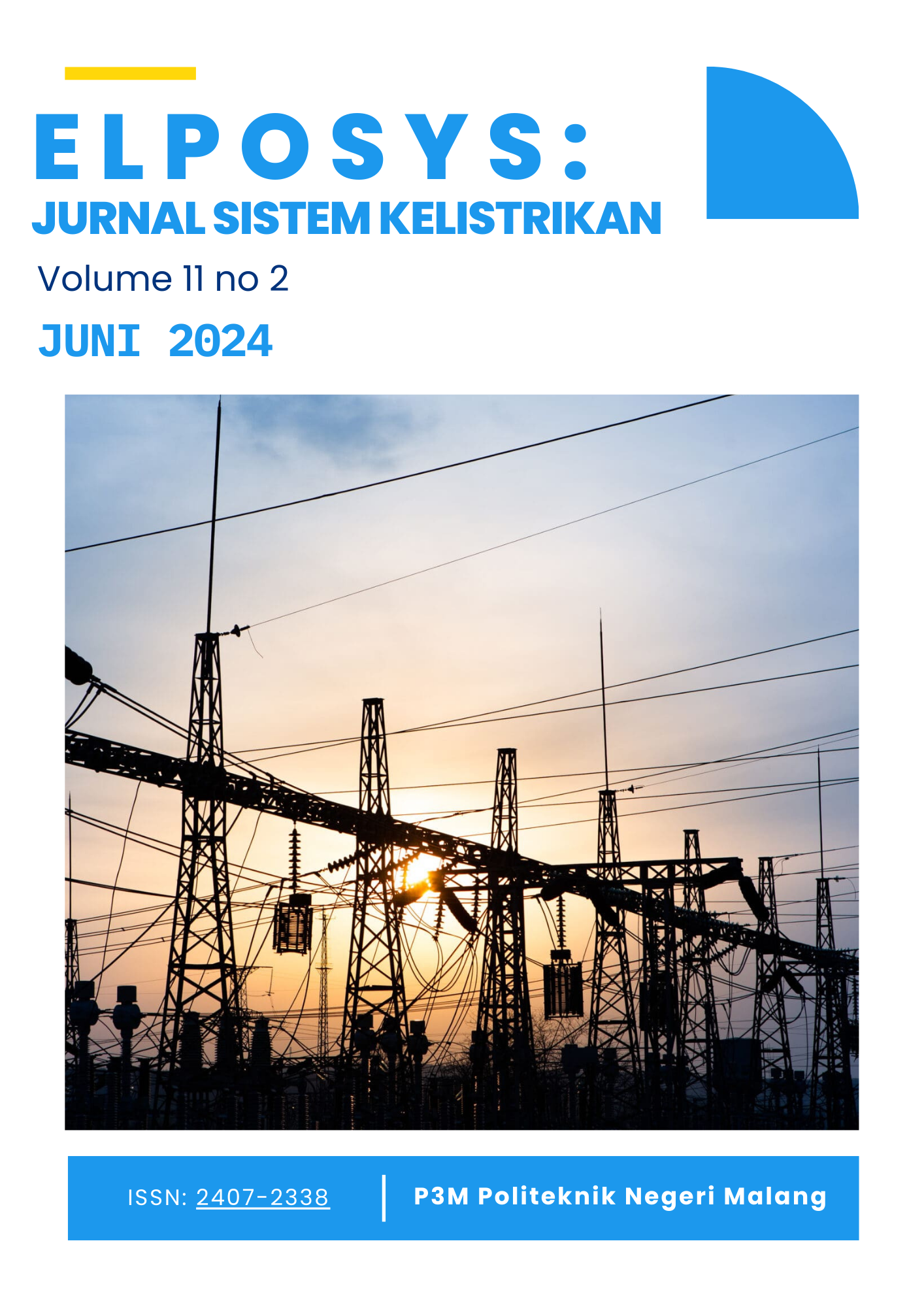Inovasi Modul Monitoring Parameter Listrik Pada PHB-TR 400/230V Berbasis Mikrokontroller
DOI:
https://doi.org/10.33795/elposys.v11i2.5247Keywords:
Distribution System, Maintenance, Monitoring, PHB-TRAbstract
The reliability of electrical energy distribution is paramount to continuously meet consumer demands. Effective maintenance of the distribution system, particularly the low voltage switchgear (PHB-TR), is essential to ensure this reliability. A significant challenge arises from the fact that many distribution substations are situated in remote or hard-to-access locations, complicating the maintenance process for technicians. This study aims to design and develop an innovative module for monitoring current and voltage, utilizing the Arduino Nano microcontroller, equipped with a PZEM sensor module and an I2C LCD display. The primary objective is to facilitate remote monitoring and enhance the efficiency of maintenance operations at these substations. The research methodology encompasses the design, simulation, and testing phases of the monitoring module applied to a 400/230 V PHB-TR. The module's performance was evaluated based on its accuracy in measuring current and voltage. The findings indicate that the developed module exhibits high accuracy, with an average current sensor error margin of 2.9% and a voltage sensor error margin of 1.3%. The implications of this research are significant for the field of electrical distribution maintenance. The implementation of this monitoring system can lead to substantial improvements in time and energy efficiency, as well as enhanced safety for maintenance personnel. Moreover, it facilitates real-time remote monitoring, which is particularly beneficial for substations located in challenging terrains. This innovation holds the potential to streamline maintenance processes and ensure a more reliable supply of electrical energy to consumers.
References
I. Made et al., “PENEMPATAN DAN PEMILIHAN KAPASITAS TRANSFORMATOR DISTRIBUSI SECARA OPTIMAL PADA PENYULANG PERUMNAS,” J. Resist. (Rekayasa Sist. Komputer), vol. 4, no. 1, pp. 33–44, Apr. 2021, doi: 10.31598/JURNALRESISTOR.V4I1.722.
A. A. Pradana, P. Yuliantoro, and S. Indriyanto, “PERANCANGAN SISTEM MONITORING DAYA LISTRIK 1 FASA PADA RUMAH TANGGA BERBASIS INTERNET OF THINGS,” J. SINTA Sist. Inf. dan Teknol. Komputasi, vol. 1, no. 1, pp. 1–9, Jan. 2024, doi: 10.61124/SINTA.V1I1.13.
W. Istiana, R. P. Cahyono, and T. Komputer, “Perancangan Sistem Monitoring dan Kontrol Daya Berbasis IoT,” Portaldata.org, vol. 2, no. 6, pp. 2022–2023, 2022.
A. Y. B. Dawe, P. D. P. Adi, and W. Dirgantara, “SISTEM MONITORING UNTUK PENGGUNAAN DAYA LISTRIK PADA SMARTHOME WITH METHOD FUZZY LOGIC BERBASIS IOT,” SinarFe7, vol. 4, no. 1, pp. 554–564, Dec. 2021.
A. Goeritno and F. Hendryan, “Monitoring dan Kendali Tegangan Jaringan Listrik Fase-tiga melalui Smartphone,” J. RESTI (Rekayasa Sist. dan Teknol. Informasi), vol. 6, no. 1, pp. 32–40, Feb. 2022, doi: 10.29207/RESTI.V6I1.3662.
Lulu Sabillah and R. Hidayat, “Sistem Monitoring Pemakaian Energi Listrik Pada Kamar Kost Menggunakan Aplikasi Blynk Berbasis Internet of Things,” J. Komput. dan Elektro Sains, vol. 1, no. 2, pp. 25–29, 2023, doi: 10.58291/komets.v1i2.104.
N. Onasie and S. Sulaiman, “Perancangan Sendok Makan Parkinson dengan Metode PID Berbasis Arduino. Elektroteknika,” Techné J. Ilm., vol. 22, no. 1, pp. 33–48, 2023.
F. P. E. Putra, A. Baidawi, A. A. Mubarok, and Frediyanto, “Merancang Jaringan Sensor Nirkabel dan IoT untuk Kota Pintar Pamekasan,” J. Inf. dan Teknol., pp. 138–145, Jul. 2023, doi: 10.37034/JIDT.V5I2.331.
Y. Hardiyani, S. Nisworo, and H. T. Setiawan, “Perencanaan Sistem Deteksi Formalin pada Makanan,” ULIL ALBAB J. Ilm. Multidisiplin, vol. 2, no. 2, pp. 569–578, Jan. 2023, doi: 10.56799/JIM.V2I2.1135.
J. Jamal and T. Thamrin, “Sistem Kontrol Kandang Ayam Closed House Berbasis Internet Of Things,” Voteteknika (Vocational Tek. Elektron. dan Inform., vol. 9, no. 3, pp. 79–90, Sep. 2021, doi: 10.24036/VOTETEKNIKA.V9I3.113430.
M. Arif Budiman, A. Zatulo Harefa, and D. Virgian Shaka, “Perancangan Sistem Pelacak Gps Dan Pengendali Kendaraan Jarak Jauh Berbasis Arduino,” Proceeding SENDIU 2020, pp. 356–363, 2020.
A. Mahendra, R. Dan, and Y. Calvinus, “STUDI PENGUKURAN JARAK ANTARA TIGA XBEE DENGAN ARDUINO SEBAGAI DATA COUNTER,” J. Tek. Ind., vol. 8, no. 1, Oct. 2021, doi: 10.35968/JTIN.V8I1.804.
J. Asmi and O. Candra, “Prototype Solar Tracker Dua Sumbu Berbasis Microcontroller Arduino Nano dengan Sensor LDR,” JTEV (Jurnal Tek. Elektro dan Vokasional), vol. 6, no. 2, pp. 54–63, May 2020, doi: 10.24036/JTEV.V6I2.108504.
D. Okky Anggriawan, A. Rifki Fauzi, E. Wahjono, T. Elektro Industri, P. Elektronika Negeri Surabaya, and J. Raya, “RANCANG BANGUN KWH METER DIGITAL 1 PHASE PROGRAMMABLE BERBASIS IOT,” Pros. Semin. Nas. Terap. Ris. Inov., vol. 8, no. 1, pp. 122–129, 2022.
C. Pradhana and M. Sulaiman, “Simulasi Komunikasi Serial Dengan Protokol I2C Menggunakan Arduino IDE dan Proteus 8,” SinarFe7, vol. 3, no. 1, 2020.
R. Regivan and A. Almasri, “ANALISIS PERBANDINGAN IC REGULATOR LINIER DENGAN IC REGULATOR SWITCHING DALAM RANGKAIAN REGULATOR TEGANGAN PADA POWER SUPPLY DC,” Ranah Res. J. Multidiscip. Res. Dev., vol. 1, no. 4, pp. 1090–1099, Aug. 2019.
Downloads
Published
How to Cite
Issue
Section
License
Copyright (c) 2024 Elposys: Jurnal Sistem Kelistrikan

This work is licensed under a Creative Commons Attribution-NonCommercial 4.0 International License.








